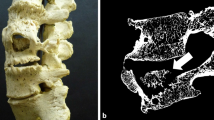Summary
Quantitative studies of the influence of anticonvulsant drugs on bone mineral content of 88 epileptics were performed by a microcomputer-aided densitometer system. The results showed that the mineral content decreases significantly with the duration of the therapy. This decrease was found to be approximately 1.2% per year for a Diphenylhydantoin (DPH) monotherapy and 1.8% per year and 2.0% per year for a DPH plus Phenobarbital and DPH plus Carbamazepin combination therapy.
Similar content being viewed by others
References
Ashworth B, Horn DB (1977) Evidence of osteomalacia in an outpatient group of epileptics. Epilepsia 18:37–43
Christiansen C, Rødbro P, Lund M (1973) Incidence of anticonvulsant osteomalacia and effect of vitamin D: controlled therapeutic trial. Br Med J 4:695–701
Dent CE, Richens A, Rowe DJF, Stamp TCB (1970) Osteomalacia with long-term anticonvulsant therapy in epilepsy. Br Med J 4:69–72
Egli M (1979) Interaktionen bei antiepileptischer Kombinationstherapie. Dtsch Med Wochenschr 104:260–265
Fritsch R, Heyer R, Freyschmidt J (1981) Röntgenologische Skelettveränderungen bei antiepileptischer Therapie im Kindesalter. RÖFO 134:56–61
Griffith ER, Stonebridge JB, Lehmann JF (1973) Current methods of in-vivo measurements of osteoporosis. Am J Phys Med 52:75–91
Hahn TJ, Birge SJ, Scharp CR, Avioli LV (1972) Phenobarbital-induced alterations in vitamin D metabolism. J Clin Invest 51:741–748
Hahn TJ, Scharp CR, Richardson CA, Halstead LR, Kahn AJ, Teitelbaum SL (1978) Interactions of Diphenylhydantoin (Phenytoin) and Phenobarbital with hormonal mediation of fetal rat bone resorption in vitro. J Clin Invest 62:406–414
Kruse K (1981) Einfluß der antikonvulsiven Langzeittherapie im Kindesalter auf Sekretion und Wirkung von Parathormon und Calcitonin sowie auf die tubuläre Calcium- und Phosphatrückresorption, Habilitationsschrift, Universität Kiel
Kruse R (1968) Osteopathien bei antiepileptischer Langzeittherapie. Monatsschr Kinderheilkd 116:378–380
Schmidt F (1967) Osteopathien bei antiepileptischer Dauerbehandlung. Fortschr Med 85:381–382
Sonnenberg A, Sonnenberg GE (1978) Osteopathien durch Antikonvulsiva: Pathogenese, Klinik und Therapie. Fortschr Neurol Psychiatr 46:248–259
Sotaniemi EA, Hakkarainen HK, Puranen JA, Lathi RO (1972) Radiologic bone changes and hypocalcemia with anti-convulsant therapy in epilepsy. Ann Intern Med 77:389–394
Vanselow K, Heuck F (1970) Kritische Überlegungen zur radiologischen Bestimmung des Knochenmineralgehaltes. RÖFO 112:344–353
Wolschendorf K, Vanselow K, Schwesig W (1980) Die Bestimmung des Knochenmineralgehaltes mit Hilfe einer mikroprozessorgestützten Densitometeranlage. Biomed Techn [Suppl] 25:133–135
Author information
Authors and Affiliations
Rights and permissions
About this article
Cite this article
Wolschendorf, K., Vanselow, K., Möller, W.D. et al. A quantitative determination of anticonvulsant-induced bone demineralization by an improved X-ray densitometry technique. Neuroradiology 25, 315–318 (1983). https://doi.org/10.1007/BF00439210
Received:
Issue Date:
DOI: https://doi.org/10.1007/BF00439210




